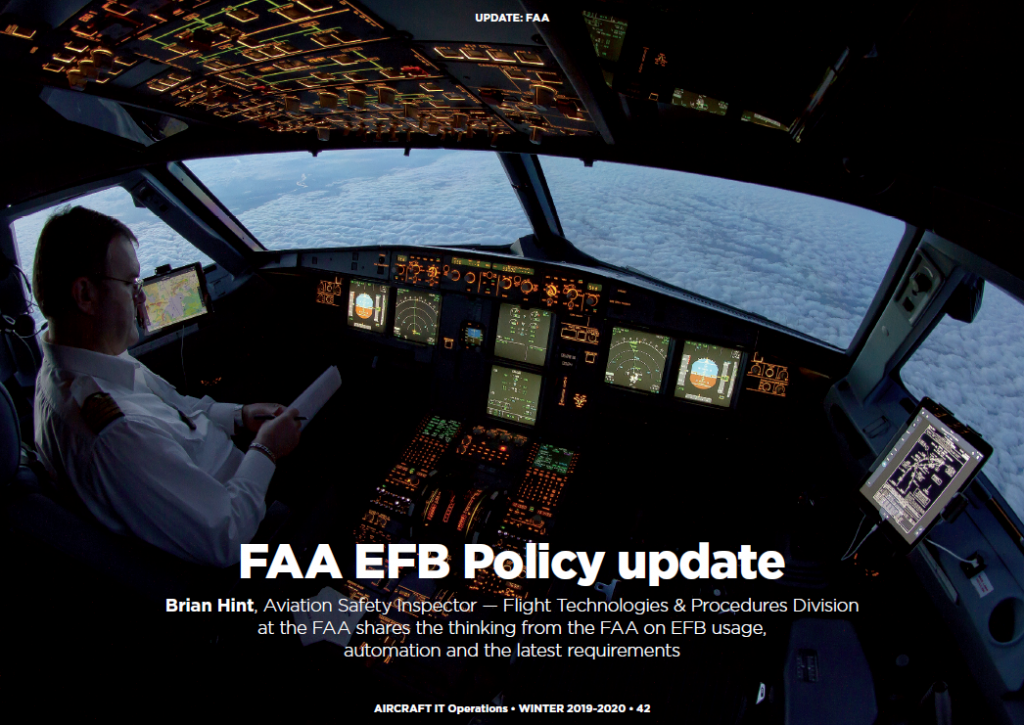Articles
| Name | Author |
|---|
White Paper: FAA EFB Policy Update
Author: Brian Hint, Aviation Safety Inspector — Flight Technologies & Procedures Division at the FAA
Subscribe
Brian Hint, Aviation Safety Inspector – Flight Technologies & Procedures Division at the FAA shares the thinking from the FAA on EFB usage, automation and the latest requirements
It is always a pleasure to share with Aircraft IT readers updates to the Federal Aviation Administration (FAA) EFB policy and things are a little bit different this time, reflecting the growing maturity of EFB usage. While I have continually focused on the future of FAA EFB policy, the conversation today is about utilizing existing policy to create and utilize new and novel concepts, which have been briefed and accepted by FAA’s leadership. The topics that I will cover in this article will include:
- Alternative EFB Device Usage
- Automated EFB Concept
- Display of Own-Ship Position (No Glass)
- New EFB Applications
We will focus on the first two inasmuch as the first is about industry stakeholders coming to the FAA and asking for help when EFB devices, for whatever reason, are unavailable for use. The second has to do with the paper I wrote in September of 2018, which has sparked some conversations, in a good way, about what could possibly be done with EFBs utilizing existing technologies. The last two points discuss issues on what I consider an equivalent level of safety to paper: that has been a foundational argument for why we are able to display this information on a commercial-off-the-shelf (COTS) electronic device versus the traditional paper.
ALTERNATIVE EFB DEVICE USAGE
So, first off, what happens when an EFB becomes unavailable? Let us start with the rules; with 14 CFR (Code of Federal Regulations) and its various parts. The rules do not say you need more than one device and they do not mention the word ‘paper’. The FAA’s General Council has ruled that, if something is going to be shown in a digital form, it must satisfy the requirements that are set out in 14 CFR. The FAA’s general risk mitigation strategy is to have more than one operational EFB in the unlikely case one of the EFBs becomes unavailable. However, there is nothing in 14 CFR preventing pilots in the cockpit from sharing information utilizing one EFB. And this scenario does occasionally happen – maybe the software fails (unlikely) or the battery wasn’t charged and perhaps the charging point is not available (still unlikely), or they forgot their device, etc.
As an aviation safety inspector, from my perspective it does not make sense to print out a bunch of paper at an outstation, throw it in a garbage bag and then say, ‘Okay, we’ve satisfied the rules’. What we want is for pilots to be able to use a device in a similar fashion with those habitual patterns in the cockpit that lead to safety; to be able to use that same device over and again like they normally do. The FAA does not outline any individual strategy for what to do when one EFB is inoperative in the cockpit. In addition, there is a dramatic difference between flight attendant use of EFBs for the flight attendant manuals and flight deck crews (the pilots) use; having to do primarily with the physical proximity the crewmembers may or may not be in with respect to each other. In the flight deck, there is always one pilot flying the airplane and one pilot monitoring. The pilot monitoring is primarily responsible for using the EFB to read the checklists, review dispatch paperwork, etc.
Although our policy did not originally reflect the idea of temporarily utilizing a personal device, in today’s age, everyone has his or her own device. And we think it’s safer for a pilot to temporarily use their own device as long as they can satisfy to their Principle Operating Inspector (POI) that the information being obtained from that device is up to date, that it’s legible and secure. However, because this would not be the primary EFB device, the FAA would have to look at the evaluation and considerations for use slightly differently from primary EFB devices. For example, would rapid decompression testing offer any risk mitigation? I would suggest not since the primary EFB device was already tested, and available for use in the unlikely event of a rapid decompression event. However, 14 CFR requires EMI testing, and so those considerations in our policy would still need to be considered.
The goal is to not prescribe a specific way in which an operator can show that certain devices can be used temporarily in place of their primary EFB; we’re simply saying that we’re open to the idea of having the operator come to the FAA and present to us basic considerations that they would have for their crew members to temporarily utilize their own device to acquire the same information that they were trying to display before on their primary EFB device. Again, separate from the flight attendants because their roles, their responsibilities, their physical proximity to one another or not, are different.
In terms of what is going to go into the FAA’s policy, the rule doesn’t stop an operator today proposing a new idea as I just described above where they say, ‘OK, if it’s this type of device and it’s this size, with this amount of battery power and can automatically connect to the mobile device management company, etc.;’ that’s allowed today. There is information in INFO 13002 which might get updated in the future but it’s an INFO, not a regulation, so it doesn’t prevent an operator from suggesting these types of changes to their POI. I can say that we’ve already talked to a number of POI’s in the field about this idea and they’re completely open to it, knowing also that this particular INFO exists.
We’re focused now on the rules more than anything and, if existing policy supports that, great, and even if it doesn’t, lets still focus on the rules. If the rules don’t say it’s prohibited, then work with us at the FAA and we’ll try to make this happen.
AUTOMATED EFB CONCEPT
From my perspective, using an EFB in the Air Force Reserves, and also performing enroute inspections on all the carriers, I’m generally familiar with how pilots are using the EFB in the cockpit, and what their capabilities are with and without datalink.
In my opinion, operators are still not fully utilizing this very capable device. We are still focused on offering information in a two-dimensional style traditional to paper. Meanwhile, these devices have the capabilities to offer pilots information in a completely different manner, and one in which pilots can access information easier with the ability to digest the information with greater efficiency. With a piece of paper, you were limited as to how much information you had to present to the pilot. You’re also responsible for giving them all the information that they could possibly want and cramming that into a space that takes up the least amount room. Potentially, that can all change if we think outside the way information was once presented in paper form.
EFBs can be stand alone or connected to the avionics via a data bus; they can also be connected to the ground via the Wi-Fi which opens up a whole host of information that could be ingested to the EFB. Really, the EFB knows where it is, knows the condition of the aircraft, the fuel on board; it knows the weather ahead: it can constantly think about, what’s happening now, what’s going to happen in the future, what are the changes happening on the ground, it can think about things like ground delays… all information that would not normally have been provided to a pilot because that would have led to information overload. But there is something else the EFB can do and that is to ingest all that information and then, using machine learning, part of AI, it can concentrate on presenting the right information at the right time to the pilot.
That’s the cornerstone of this idea; that you want to be able to provide the right information at the right time and, at the same time, if the pilot wants other information that’s not being automatically provided, it can be easily obtained. This idea that we’re using PDF viewers to get information is wrong. We all interact with our own personal devices and the devices in our cars and our homes completely differently than we do in an aircraft. I believe that the use of EFB technology is getting better but it should be much easier to acquire specific information in the air. We should be able to ask our EFB, ‘what are my alternates right now, within a hundred miles?’ And it should show the Ops Spec, your authorized destinations, but also offer suggestions such as that the runways might be closed on one airport, that another airport has good weather conditions, here’s the applicable NOTAMS for this airport, etc. the sky is the limit.
However, it’s not as if this isn’t happening today. There’s a major chart manufacturer where, when you cross, for instance, the North Atlantic, there are certain steps that have to be made going from the East Coast of the United States over to Europe and one of them is logging on to CPDLC (Controller-Pilot Data Link Communication); another is obtaining Oceanic clearance: these are things that pilots must always do. But this App is smart enough to say, ‘I know what your flight plan is; I know where you are right now; so I’m just going to turn on the device with a notification to remind you that it’s time for you to log-in to CPDLC.’ It will even offer some frequencies that the pilot might want; VHF, HF. That means that the pilot doesn’t have to look up that information and doesn’t have to bother ATC. That is providing the right information at the right time and automatically.
Think of this from pre-flight all the way through block-in. The moment a pilot steps on board an aircraft it should automatically recognize that pilot, know what the flight plan is and know what the pilot wants; so, why not offer the pilot information as they go through their flows in the cockpit? The device should have digital ATIS (Automatic Terminal Information Service) already up; it should already have a copy of the aircraft’s clearance for the flight… and all that is stand-alone. In the future, it could be one of those things where you’re looking at the information and you push to load automatically from the EFB to the FMS (Flight Management System). It’s the same with frequencies for example, when flying, why can’t a pilot touch a frequency on the EFB and have that pre-loaded into the standby side of the Comms box?
The sky is the limit; these ideas are completely within reach of the current policy. The FAA is basically asking the industry, ‘you have this very capable device, we understand that implementation costs money but we (the FAA) see it as a major improvement to safety when done right: and what we’ve seen so far is already a major improvement to safety. So we’re asking for more from operators, from manufacturers… we want people to think outside of the box.’ You are not limited as to how you present information to pilots; it doesn’t have to be a standard document in the way we see it today. The way that pilots brief for an approach was limited to this 2D plan and profile view on an approach chart but is that the best way to provide information to a pilot? I would argue no, it’s not. Notwithstanding any of that, the leadership from the top down in the FAA is open to these ideas and we would be very interested to work with industry, the airlines and the operators, if you have such ideas already.
OWN SHIP POSITION
There has been a bit of a shift in the way that we’ve discussed the capabilities of ‘own ship position’ and what can and cannot be done based on whether there is a glass cockpit. When we worked on this whole idea of ‘own ship’, the basic premise was, based on aircraft certification policy, if you have redundancy, then you can downgrade the failure condition of a function. With that being said, we used the argument of concurrence and differentiation when it came to display of own ship as an EFB function. So, as long as the pilot had a Nav display with ‘own ship’ on it, there would be an easy way to detect erroneous information if it were displayed on the EFB because undetected erroneous information was the failure condition that we were worried about. The mitigation is that the pilot can easily cross-reference his Nav display against an EFB and trust the certified (Nav display) versus the uncertified (EFB) equipment. We’ve also always said for operators who are still non-glass, it’s still possible but that was misleading because the way that this policy has been set means that you can’t satisfy any of the basic requirements we’ve created unless there is concurrence.
Fortunately, most operators these days are flying with glass cockpits but the FAA has to come clean to say that there really is not an alternative strategy right now. So, with glass, you can get ‘own ship’ but without glass, you can’t get it.
NEW EFB APPLICATIONS
Finally, the FAA does have a process for new EFB applications and was working on the fifth one at the time of writing.
If you bring the FAA a new application, you’ll be looking at about four months from the time that the application is submitted to the time when the FAA will approve and give you a letter that can be used as justification to your POI that the subject of the application can be considered for use with your EFB; and, at some point, that will get incorporated into the Advisory Circular.
Contributor’s Details
Brian Hint

Brian Hint is an Aviation Safety Inspector (Operations) with the Federal Aviation Administration. For the past two years, he has supported the Future Flight Technologies Branch (AFS-430) located at FAA Headquarters, Washington DC. The focus of the branch is the integration of evolutionary and revolutionary technology, along with new technology-based operations, into the FAA’s vision for the Next Generation Air Transportation System. Brian is the subject matter expert for Portable Electronic Flight Bag policy.
FAA

The Federal Aviation Administration (FAA) is the national aviation authority of the United States. An agency of the United States Department of Transportation, it has authority to regulate and oversee all aspects of American civil aviation.
Comments (0)
There are currently no comments about this article.

To post a comment, please login or subscribe.